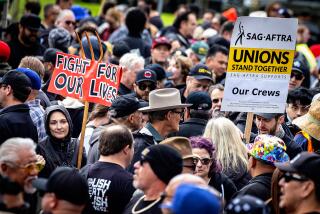Behind the Scenes of SAG Strike
- Share via
When Jeff Manning’s telephone rang on Sept. 6, the executive director of the California Milk Processor Board unexpectedly found himself at center stage in the increasingly bitter commercial actors strike. Three “Got Milk?” television commercials soon would begin filming with a cast of nonunion talent, but striking actors now were urging him to sign an interim labor agreement.
Manning decided to break ranks with the nation’s most powerful advertisers and sign the agreement, which included higher cable television residuals for actors. The board that promotes the state’s $3-billion milk industry was then free to use a blend of union and nonunion talent in the spots.
The “Got Milk?” spots that began running last week underscore the important role actors continue to play in a noisy media arena that is moving beyond broadcast and cable television into the complicated world of broadband technology and wireless communication devices.
Whether it’s retired defensive end Howie Long pitching computers for Radio Shack or newcomer Rob Cobuzio making his commercial debut in the new “Got Milk?” spot, actors still can give marketers an edge in the high-stakes business of shaping consumer wants and desires.
Advertising expenditures rose by 14.9% to $47.7 billion during the first half of 2000, according to New York-based Competitive Media Reporting, with the lion’s share going toward purchasing air time for television commercials.
With a $25-million marketing budget, the milk board is a small player. But it faces the same market pressures as giants such as General Motors, which will spend more than $2 billion this year on marketing and advertising. Ineffective ads could let thirsty consumers slip away to such powerful marketers as Coca-Cola and Pepsi.
Commercials continued to be produced during the strike. Radio Shack marketed its wares without the services of Long, who, like many celebrities, refused to cross picket lines. McDonald’s spotlighted company employees in commercials, and Home Depot featured Olympic athletes. Procter & Gamble used a cartoon bear to pitch toilet paper.
But while a car company might survive an actors strike by shifting the commercial emphasis to rough-and-tumble trucks, the milk board’s highly formulaic commercials turn on actors.
“We could show beauty shots of milk being poured, but it would be a waste of money,” Manning said. “It’s crucial that we get the right actor for each spot because that’s what people are going to remember--certainly not the glass of milk.”
The award-winning “Got Milk?” spots revolve around quirky incidents in which the supply of milk unexpectedly evaporates. In one commercial, an actor playing a priest attacks a vending machine that fails to deliver a carton of milk. In another, an Aaron Burr fanatic with a mouthful of peanut butter frantically shouts “Aaaawon Buuuuhh” into the telephone during a failed attempt to win a radio contest.
Goodby, Silverstein & Partners, the milk board’s San Francisco-based advertising agency, had created 40 “Got Milk?” spots since October 1993. Before the strike, the agency’s creative work had been interpreted by talent from the Screen Actors Guild and the American Federation of Television and Radio Artists--including the distinctive voice of an AFTRA national board member who delivers the “Got Milk?” tag line.
“The milk commercials are especially sensitive to good and bad acting,” said agency co-founder Jeff Goodby. “They’re dramas about life, and when life isn’t as lifelike as it should be, the commercials don’t work. There obviously are good nonunion actors out there, but we obviously want to have the greatest possible variety of casting to choose from. And, to do that, you need union people.”
A lengthy talent strike wasn’t on Manning’s radar in May when the Goodby, Silverstein creative team assembled at his Berkeley office loft. During the next month, the agency rummaged through a grab bag of ideas, eventually developing a handful of scripts that were tested by focus groups.
As the summer progressed, Jeff Goodby told Manning that casting directors would be soliciting nonunion talent because of the strike. “We needed to be back on television in October with new spots,” Manning said. “So I didn’t hesitate. I was adamant that we go ahead and find the [nonunion] talent that we needed. And Jeff told me they were having pretty good luck casting for other things they’d been shooting.”
The San Francisco office operated jointly by AFTRA and SAG quickly learned that nonunion actors were being cast for the milk spots.
Even though Jeff Goodby earned SAG membership while appearing years ago in spots his agency created, union members knew the agency wouldn’t sign an interim agreement. Members of the American Assn. of Advertising Agencies, who produce 75% of the country’s advertising, and the powerful Assn. of National Advertisers had pledged not to use union talent during the job action.
“I told Jeff [Manning] I had to stay out of it,” Goodby said. “But I also told him I’d be glad to work with him if he did sign it--in fact, I was relieved that he might sign the interim agreement because it would give us access to a wider pool of good actors.”
San Francisco strike organizers, meanwhile, were working the telephones and going online to research how milk is produced and marketed. Speaking directly to advertisers was a new role for the actors unions. “The strike allowed us, or forced us, to forge these kinds of new relationships,” said Karen H. Lipney, assistant executive director of the SAG/AFTRA office in San Francisco, one of several staffers who brokered the milk deal.
By Labor Day weekend, actors had watched General Motors travel to Canada to film a Buick commercial with Tiger Woods. Burger King had brought the Backstreet Boys to Canada for its own spots. Actors were laying groundwork with the AFL-CIO for a jointly sponsored boycott of Procter & Gamble’s Tide, Crest and Ivory Snow products.
Manning had been hearing stories of commercial shoots moving to Canada to avoid strikers. He began to wonder what would happen when his production moved to Los Angeles to take advantage of sunny skies, readily available crews and easily accessible locations.
Los Angeles’ economy clearly was feeling the impact of the strike. During September, the number of commercial production days completed in Los Angeles tumbled to 168, according to the Entertainment Industry Development Corp., down from 533 during September 1999. Economists projected that the strike was carving $2 million each day out of the local economy.
With $1.1 million committed to the upcoming shoot, the milk board stood to lose as much as $300,000 if production didn’t begin on schedule. Manning knew there was a potential for the shoot to be interrupted by picketing actors, a potentially costly disruption.
“I was willing to sign the agreement if it didn’t unduly penalize me,” Manning said. After milk board attorneys estimated that the agreement would add $40,000--the amount unions wanted for cable television exposure--to the cost of completing the spots, Manning agreed to sign. The board hopes to spread the added cost out over the next 18 months as the ads appear.
Union leaders quickly faxed a copy of a proposed news release that Manning approved. “Mr. Manning took a courageous step when he went ahead,” Lipney said. “A lot of advertisers wouldn’t have stuck their necks out. He’s a smart man, he knows what sells--who sells--the milk.”
Manning credits union leaders with “doing what needed to be done to get our job completed. I signed because my business isn’t about being pro-union or anti-union. My business is about selling milk.”
On Sept. 18, nearly 70 crew and cast members and caterers assembled in Los Angeles to film the spots. Though many roles already had been cast with nonunion actors, union leaders touted the agreement as a significant victory.
Crews had to erase union rhetoric spray-painted at a location in Northridge, and one actress reported receiving death threats. But production progressed smoothly. Crew members say the only evidence of a strike was increased security at the set and guards who were posted each night outside actors’ homes.
“The death threat thing was really stepping over the line,” Manning said. “But I mark it up to the actions of a few weirdos, some really wacky people. It wasn’t SAG or AFTRA leadership. They were true to their word.”
When cameras rolled on newcomer Cobuzio’s spot, the biggest challenge appeared to be getting Maggie, a 7-year-old chimpanzee, to stick to the script. As trainer David J. McMillan of Canyon Country-based Worldwide Movie Animals coaxed the chimp through a rehearsal, Cobuzio talked about his role in what turned into Hollywood’s longest talent strike.
“This is such a great opportunity because the spot is highly comedic and very visible, and I’d come into contact with people who can hire me later on,” said Cobuzio, who works as an office supervisor to pay the bills. “But the audition process was really arduous. With the [interim agreement], there’s a huge weight taken off my shoulders. My intention was never to take away someone else’s job.”
During Cobuzio’s brief stay on camera, the actor uses a MoonPie marshmallow sandwich to taunt Maggie, who shakes her cage while trying to grab the snack. In the second new spot, thirsty ants carry away crumbs from a family’s picnic. In the third, a 40-year-old man reminisces about tasty Toll-House cookies from his youth.
Each spot, of course, ends with a frustrated grab for the inevitably empty milk carton. Goodby said the commercials shot during the strike are in keeping with the quality found in pre-strike work: “I think we got lucky.”
More to Read
The biggest entertainment stories
Get our big stories about Hollywood, film, television, music, arts, culture and more right in your inbox as soon as they publish.
You may occasionally receive promotional content from the Los Angeles Times.










